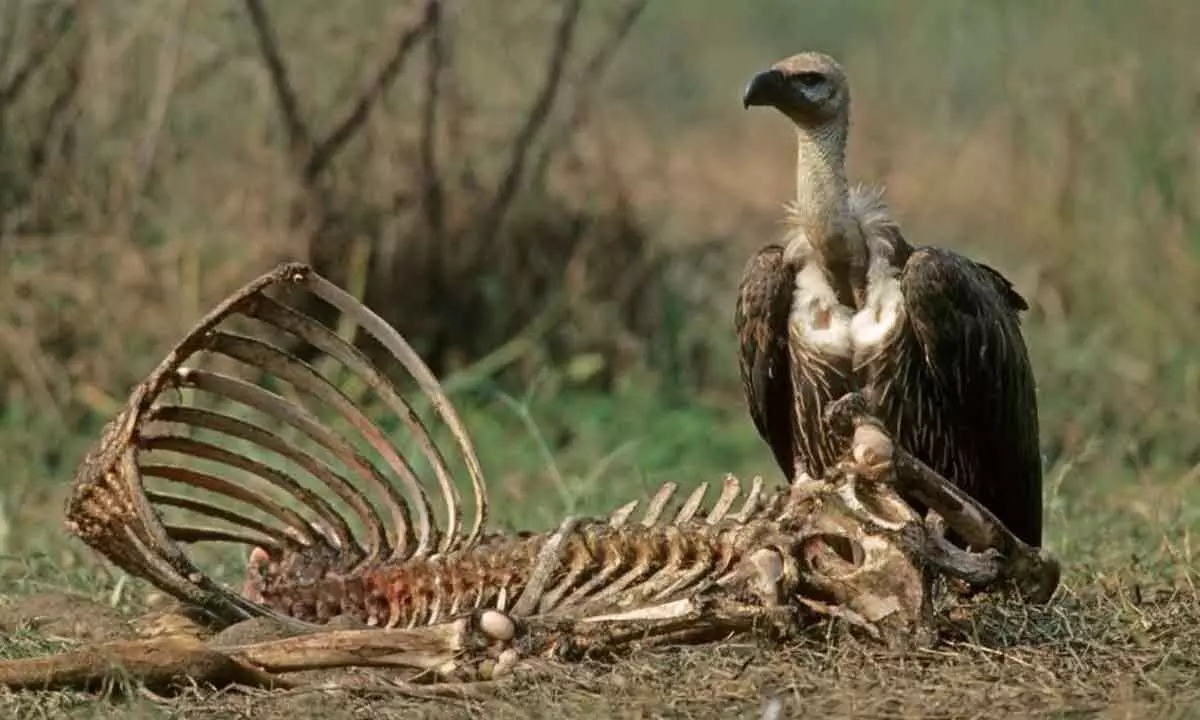Live
- Vivo Warns the Risks of UV-Cured Screen Protectors; Check Vivo's Recommendations
- BJP, Congress turncoats in AAP's first list
- Adani tried to enter Delhi's power sector: AAP's Sanjay
- International Kabaddi Federation sanctions World Super Kabaddi League 2025
- Pollution crisis fuels demand for CNG, BS-6 vehicles during wedding season
- Solar panels empowering UP farmers, says Yogi
- Bomb cyclone leaves hundreds of thousands without power in US
- Is Pushpa-2 Postponed Again? Here’s What Makers Said
- Narsipatnam tank bund my dream project, says Speaker
- MLA Yashaswini slams Errabelli
Just In
Measuring scavenging value of vultures


The ecosystem value of carcass disposal services by vultures is thus calculated to be the same, as the avoided cost in setting up carcass rendering plants. According to a study, the lifetime value of 600 captive-breed vultures for their scavenging services was calculated to be between Rs 160.46 million and Rs 145.71 million in urban areas and Rs 137.87 million to Rs. 127.83 million in rural areas
A new paper evaluating the economic feasibility of vulture conservation in India has found there is an “overwhelming support” for the captive breeding and release of Gyps vultures into safe zones for a cost-effective, natural solution to carcass disposal. Indian captive breeding centres started releasing vultures into the wild as recently as 2021.
Vulture populations in India plummeted after the widespread use of diclofenac on cattle, a non-steroidal anti-inflammatory drug which turned out to be toxic for vultures that would feed on the cattle. The recent paper captures the value of carcass disposal services provided by vultures by comparing the costs of government run carcass rendering plants with the costs of captive breeding and the subsequent release of vultures. “Such an investment in augmenting wild vulture populations in Protected Areas and urban landscapes would save the government millions of rupees while also maintaining the overall health of the ecosystem, the wildlife, livestock, and the local communities,” the paper states.
Value in scavenging
Before their populations declined, vultures would consume between 5 to 10 million carcasses of cows, camels and buffaloes annually. The sharp decline in vulture populations following the widespread use of diclofenac in the 1990s led to the rise of other scavengers who inadvertently facilitated the spread of diseases. The near removal of vultures from society led to an increase in 5.5 million feral dogs, 38.5 million additional dog bites and more than 47,300 human deaths from rabies from 1992 to 2006, according to a study done in 2008. The Indian government banned diclofenac for veterinary use in 2006. The loss of vultures also caused a setback for the Parsi Zoroastrian community which relies on the birds for disposal of their dead bodies.
The researchers conducted a cost-benefit analysis of the vulture breeding programme, in which the costs included setting up facilities, establishing vulture safe zones and running the conservation programme. The benefits included the value of scavenging services provided by vultures once released. The value of this service was ascertained by comparing how much it would cost to recreate vultures’ scavenging services through mechanised carcass rendering plants. Rendering plants convert waste animal tissue into other products such as recycled meat, bone meal, and animal fat.
A medium-sized carcass rendering plant is capable of processing 20-25 carcasses per day. The researchers estimated it would take 600 vultures to dispose of carcasses at a similar rate. While the plants need to be replaced every 10 years, captive bred vultures are capable of providing scavenging services for 14 years and wild bred populations for 18-19 years. The ecosystem value of carcass disposal services by vultures is thus calculated to be the same, as the avoided cost in setting up carcass rendering plants. According to the study, the lifetime value of 600 captive-breed vultures for their scavenging services was calculated to be between Rs 160.46 million and Rs 145.71 million in urban areas and Rs 137.87 million to Rs. 127.83 million in rural areas.
The study was conducted at the request of the Ministry of Environment, Forests and Climate Change, and done in conjunction with the International Union for Conservation of Nature (IUCN). “While the scavenging services provided by vultures is well known, the exact value of this service, in monetary terms, isn’t. To take a monetary decision, especially for investment into such programmes, requires a monetary answer. We hope this type of study encourages strong policy actions and draws more investments to vulture conservation,” said Soudamini Das, a professor at the Institute of Economic Growth and an author of the recent research paper on the economics of conserving endangered vultures.
Vulture safe zones
“Vultures are slow breeders. Vulture safe zones (VSZ) are necessary because even now, there is a lack of awareness in some places and poisoning does happen. The birds are also threatened by other factors, like electrocution, and train accidents,” said Sachin Ranade, a scientist with the Bombay Natural History Society (BNHS) who is not associated with the study.
BNHS has been instrumental in setting up vulture conservation and breeding centres across the country in Pinjore (Haryana), Rajabhatkhawa (West Bengal), Rani Guwahati (Assam), and Bhopal (Madhya Pradesh).
According to Das, innovative financial mechanisms, like green bonds, can also be used to fund vulture conservation efforts. “The government has opened up the market for green bonds for biodiversity conservation, but most of it is for wild biodiversity. The government can also ask investors to direct their money to conserve societal biodiversity, like vultures, who provide so many benefits,” she said. (https://india.mongabay.com/

© 2024 Hyderabad Media House Limited/The Hans India. All rights reserved. Powered by hocalwire.com






